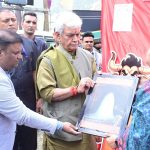The enchanting valley of Kashmir has become the epicenter of cricketing craftsmanship, as its meticulously crafted bats continue to captivate the global cricket community. Renowned for their unmatched quality and exquisite artistry, these Kashmiri-made bats have emerged as the preferred weapon for numerous prominent international cricketers.
In an astonishing turn, the Kashmiri willow bats are challenging the supremacy of the world-famous English willow. With their remarkable display at ICC events and their expanding international presence, the bat market has witnessed an extraordinary evolution. The annual bat production has surged from a modest 300,000 to an impressive 3 million, all thanks to the spotlight on Kashmiri bats on the global stage.
Hailing from the celebrated willow groves of Kashmir, these finely honed bats have found their way into the hands of elite batsmen representing diverse cricketing nations. The distinctive properties of the wood, combined with the dexterity of local craftsmen, have given rise to bats that offer unparalleled performance, garnering popularity among players of all tiers.
The international debut of Kashmiri willow bats was marked by Oman players, subsequently followed by cricketing luminaries such as Naseen Khushi, Bilal Khan, and Kalimullah. Their mastery in wielding these Kashmir-made bats attests to the exceptional feel and balance these willow wonders provide.
The custodians of Kashmiri bat craftsmanship take immense pride in their heritage, employing age-old techniques passed down through generations to fashion bats that are not only visually captivating but also elevate players’ performance. With meticulous willow selection and delicate crafting processes, each bat emerges as a unique masterpiece.
Fawzul Kabiir (30), owner of GR8 Sports Industry, recounted his endeavors to introduce Kashmiri Willow bats to Oman’s cricket board. “It was an uphill task, involving extensive travels and persuasion across cricketing nations. Eventually, the Oman Board embraced the bats, marking their debut appearance in the T20 World Cup hosted in the UAE,” Kabiir stated.
Apart from GR8, other manufacturers have also gained prominence among national and international players. Notably, in 2021, a Kashmiri willow-made bat took center stage in the prestigious Indian Premier League (IPL). The current IPL and Bangladesh Premier League (BPL) have also witnessed more powerful shots being delivered with the aid of Kashmiri willow bats.
The international acclaim garnered by Kashmiri-made bats stands as a monumental achievement for the region. It underscores the enduring heritage of bat manufacturing that has flourished in Kashmir for decades, paying homage to the skill and innovation of local artisans dedicated to perfecting the craft.
As international cricketers increasingly embrace Kashmiri-made bats, the demand for these exquisite works of art has surged. The bat-makers of Kashmir are rising to the challenge by constantly refining their techniques to meet the rigorous standards of modern-day cricket.
In the realm of cricket, where even the slightest advantage matters, the performance and allure of Kashmiri-made bats continue to make a resounding impact. These bats have become synonymous with precision, artistry, and the ethos of cricket, embodying the essence of Kashmir’s rich cultural heritage.
Amidst the global celebration of Kashmiri-made bat brilliance, the Kashmir Valley takes immense pride in leaving an indelible mark on the cherished sport, etching its legacy in the hearts of cricket enthusiasts across the world.
Safeguarding the Future:
Amidst the euphoria of Kashmiri willow bats conquering the cricketing realm, a pertinent question arises about the sustainability of their raw material. Manufacturers are raising concerns over the availability of willow trees in Kashmir, a crucial resource for bat production. While thousands of willow trees are felled annually to meet demands, doubts loom over whether an equivalent number are being replanted.
Industry insiders fear that this trend could lead to material shortages down the line. One bat manufacturer pointed out that the rate of tree planting falls short of the rate of tree cutting, creating a potential imbalance. To ensure the sustainable growth of the industry, manufacturers ardently hope that the government will intervene by enforcing a one-to-one tree replanting strategy.








